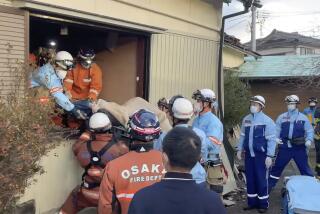Japan nuclear accident poses crisis for worker safety
Bursts of radiation being released at the stricken Fukushima nuclear plant could mean workers there will have to be quickly rotated out, and some could rapidly reach their annual exposure limit, complicating efforts to contain Japan’s continuing nuclear crisis.
“Those are pretty brave people,” David Brenner, the director of the Center for Radiological Research at Columbia University Medical Center, said of the workers. “There are going to be some martyrs among them.”
Disaster officials could face a grim choice: Scale back their containment efforts or allow workers to face radiation levels that could significantly increase their risk of cancer.
Photos: Crisis continues in Japan
Reports on Thursday indicated that at times radiation was intense enough to exceed even Japan’s newly raised annual limit in as little as an hour.
The new limit — 250 millisieverts — is five times the allowable exposure in U.S. nuclear plants and 125 times what workers typically receive each year.
That level of exposure raises the chances that workers will eventually die of cancer by 1 percentage point, according to John Boice, a cancer epidemiologist at Vanderbilt University and radiation safety expert.
Considering the scope of the disaster — and the fact that at least 20% of people already die of cancer — many workers may be willing to accept the danger. The situation becomes more complicated at higher doses, because radiation risk is cumulative. In other words, the risk of dying of cancer rises an extra percentage point with each additional 250 millisieverts.
It is not clear for how long the government will abide by its new limit.
There were conflicting reports about the amount of radiation the workers may have received so far. It also was not clear if the releases were planned and whether the workers were sheltered at the time.
At one point on Thursday, a level of 400 millisieverts per hour was recorded at the plant. That reading was an instantaneous measurement, and it was not clear how long that emission rate was sustained. But at that rate, a fully exposed worker would have to leave in 37 minutes, 30 seconds and not come back for a year to avoid exceeding the limit.
The Japanese government has tried to protect workers by keeping as few people on-site as possible, monitoring how much radiation they receive and limiting helicopter missions to drop water on the plant. Special clothing and respirators provide some protection from the damaging emissions.
“The main danger is gamma radiation,” said Elmer Lewis, a nuclear plant safety expert at Northwestern University in Evanston, Ill. “Gamma can penetrate your body no matter what you’re wearing out there. It’s like a high-powered X-ray.”
The plant workers are trained to react to crisis through simulated disasters, Lewis said.
But, he said, “there’s really no way to anticipate what we’re seeing here. They’re professionals who are doing the best with what they have.”
The most acute danger would come from a sudden release of radiation from which workers could not escape — an explosion, for example. That could cause radiation sickness, a devastating illness that is often fatal.
In the 1986 Chernobyl disaster in Ukraine, then part of the Soviet Union, the worst nuclear plant accident in history, workers who battled a weeklong fire were exposed to radiation at levels thousands of times higher than the Japanese yearly limit.
At first, people exposed to that much radiation might look normal. In a week, things change drastically.
“People’s hair starts to fall out and the burns appear and the bone marrow damage starts,” said Dr. Robert Peter Gale, a hematologist who flew to Moscow days after the accident to try to save workers airlifted there. He is scheduled to fly to Japan on Saturday to help with the Fukushima relief efforts.
Gale treated Chernobyl exposure victims with antibiotics and experimental hormones. In 13 cases, he performed bone marrow transplants in an attempt to revive their immune systems.
Of 600 workers present when the Chernobyl accident occurred, 134 developed radiation sickness, and 28 of those died within four months, according to the United Nations. Many of the rest have continued to battle health problems. Several developed cataracts.
The number of workers at the damaged Fukushima Daiichi plant during the crisis has varied from about 50 to 180, except for an hour or two when all workers had withdrawn.
Still, it is difficult to compare the accidents.
Some firefighters sent to the burning Chernobyl reactor later said they were not warned about the radiation danger, and many workers lacked protective suits and breathing devices. Soviet officials sent helicopters into the clouds of radioactive smoke to help douse the fire.
The actions of the power plant workers in Japan have already been described as heroic, and examples of heroism are common in such situations, said Dr. Fred Mettler, a University of New Mexico radiologist and advisor to the U.N. on radiation safety.
At one point during the Chernobyl disaster, he said, workers were conferring about how much water was in one reactor pool. No one knew the answer and their instruments couldn’t tell them, he said. “An Armenian engineer slipped out and came back in 30 minutes. He said, ‘There’s 3 feet of water,’ ” Mettler said. “He did that on his own.”
The engineer died soon after of acute radiation poisoning.
“Its always hard to tell what people are going to do,” he said. “Workers have done remarkable things, some things you wouldn’t expect.”
Nuclear plant workers in the United States expressed a camaraderie with their Japanese counterparts, even as they puzzled over the response to the catastrophe. “I have a lot of empathy for the Japanese people, for those workers,” said Charlie Arnone, 51, general manager of plant operations at the Waterford 3 facility on the Mississippi River in Killona, La. “They’re clearly very dedicated folks.”
Arnone, who has worked with nuclear energy since 1977, said he and other workers train according to federal Severe Accident Mitigation Guidelines, scenarios specific to each plant. They review what could happen if, for instance, they can’t maintain the water level in a spent fuel pool.
“We might hook up things, basically fire nozzles that automatically spray. Then if that doesn’t work, you can open up and try air cooling,” Arnone said. “We just have different guidelines and tools. My understanding is the Japanese don’t have that. We have all this equipment staged. We have a generator already set up, and we can pull water out of the river if we have to, to keep the core cool, the spent fuel cool.”
Experts are focusing their concern on nuclear workers because the general population’s exposure to radiation around the Fukushima Daiichi plant has so far been minimal.
The government quickly evacuated a 12-mile zone around the plant. Readings of radiation outside that area have remained low.
The utility that operates the plant, Tokyo Electric Power Co., has released gases laden with radioactive substances in small bursts to prevent the buildup of pressure inside the containment buildings. For now, the winds have cooperated in blowing much of the material out to the Pacific Ocean, where scientists say it settles in the water and is diluted into concentrations that pose little danger.
Even in Chernobyl, nobody in the general population suffered radiation sickness. The U.N. says that 6,500 cases of thyroid cancer can be attributed to the disaster, but because the cases were closely monitored and treated, only a few were fatal.
Those occurred mainly because people were not warned to stop drinking milk — the main way that dangerous quantities of radioactive iodine enter the body. The isotopes land on the grass, which is then eaten by cows, turning their milk radioactive.
“All they had to say was ‘don’t drink the milk,’ ” Boice said.
“In Japan, radioactive iodines are not going to be that big a deal,” he said. “They won’t let the milk into the food supply.”
Photos: Crisis continues in Japan
Times staff writers Molly Hennessy-Fiske, Shari Roan and W.J. Hennigan contributed to this report.
More to Read
Start your day right
Sign up for Essential California for news, features and recommendations from the L.A. Times and beyond in your inbox six days a week.
You may occasionally receive promotional content from the Los Angeles Times.







